Introduction
Bamboo is a collective name for a group of botanical species that all belong to the grass family, the Graminea. The term applies both to the living plant and to the products made from the plant. Current estimations are that more than 1600 different varieties of bamboo exist, and out of these there are some 1500 woody bamboos. Bamboos occur naturally in most parts of the world, apart from Europe. Brazil, China and India have the largest areas of bamboo of a global bamboo cover that is estimated to be nearly 50 million hectares.
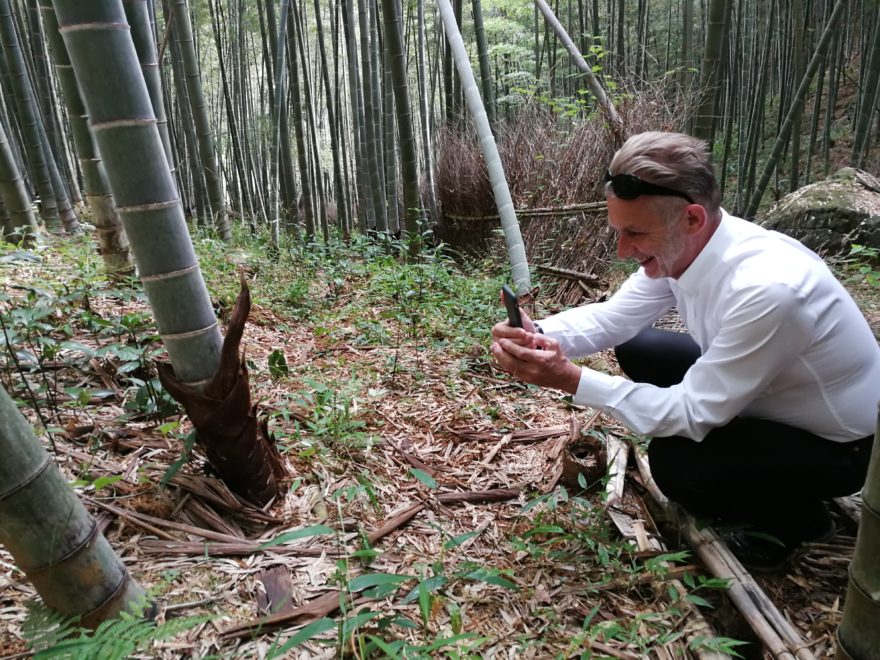
The author in Yongding, Fujian Province, China
The woody bamboos look like trees, but they are giant grass species. The larger species can reach up to 35 metres in height and can have 20 cm thick stems, while the smallest types are small bushes that are no more than 1 cm in diameter.
Some of the most important giant bamboo species are:
- Phyllostachus Pubescens, mainly from China, where it is called ‘moso bamboo’. It is the backbone of the Chinese bamboo industry.
- Guadua Angustifolia, which is especially prevalent in Latin America and has thick, large poles that are used for many uses.
- Dendrocalamus Asper, which grows predominantly in tropical regions of South and Southeast Asia, and is used extensively in construction.
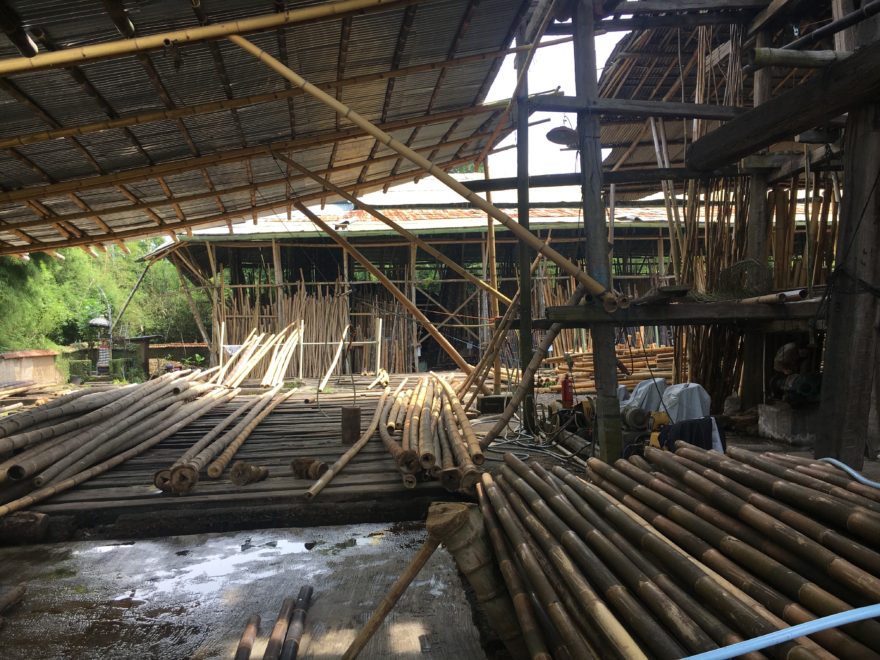
Dendrocalamus asper culms in a factory in Bali, Indonesia
Bamboo plants have an extensive root system that includes roots and underground parts called rhizomes from which the above-ground stems sprout, and one plant will have many stems, which are called culms. The rhizome system is either formed as a clump, with the culms forming a cluster or poles, or the rhizomes form individual underground root-systems with culms sprouting at irregular intervals. Bamboos of the first type are called clumping bamboos and the latter are the running bamboo species. The extensive rhizome networks help to hold soil in place and assist in soil water management, making bamboo particularly suitable for reforestation on poor grounds, erosion control and landscape management.
In general, bamboo stems are hollow, with separate sections separated by internal diaphragms. The diaphragms are visible on the outside wall of the stem as ring-shaped protrusions and this is also where the branches with the leaves sprout from. Unlike a tree trunk, bamboo culms do not extend in thickness, and do not have annual tree-rings. The thickness of a new bamboo shoot determines the thickness of the mature culms as the cells grow only in longitudinal direction.
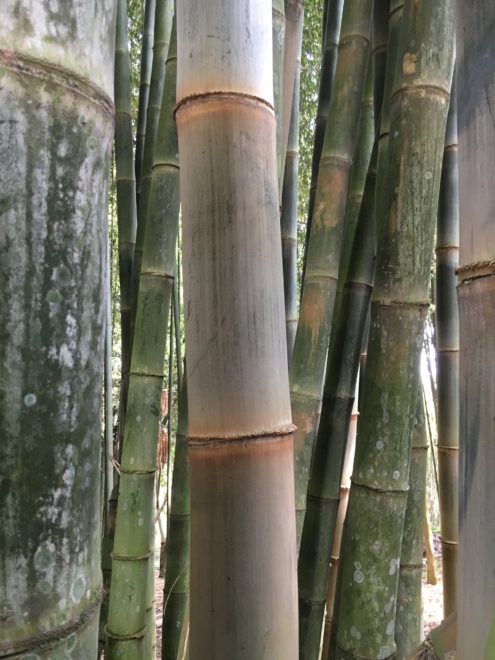
One of the most striking features of bamboo is its amazing speed of growth, as new shoots that emerge from the soil during the growing season reach their full length within a couple of months. The maximum recorded growth of Moso bamboo in China is up to 1 metre per day, which makes bamboo the fastest growing plant in the world.
Because of its fast growth, the plant absorbs a considerable amount of CO2 from the atmosphere, providing oxygen in return, and bamboo plantations are known to be more effective carbon sinks than some tree plantations. Much of the carbon is locked in the underground rhizome system of the natural system, but if bamboo poles are used for the manufacturing of durable goods, more carbon in locked in for a long time. Moreover, bamboo products can often be used as alternatives to products that produced CO2 during production, which add to the value of bamboo forests as natural carbon sinks.
During several years the bamboo culm hardens through lignification, and after some 5 to 7 years the culms are mature. This is when they can be harvested. In general, one quarter of the poles in a forest or plantation can be sustainably harvested annually without decreasing the viability of the plantation or the forest. In fact, the rhizomes do not die after harvesting and by sustainably harvesting the mature poles, the annual yield of the plantation actually increases. Although bamboo is often considered an aspect of forestry, a bamboo forest or plantation is best managed as an agricultural crop, with a pre-determined annual harvesting scheme.
Sustainable development
In 2015, the world agreed with the 2030 development agenda of the United Nations. This Agenda is a plan of action for people, planet and prosperity, which comprises 17 Sustainable Development Goals (SDGs) and 169 targets. The Goals are integrated and cannot be considered in isolation, and they combine the three dimensions of sustainable development: economic progress, social equity and environmental protection.
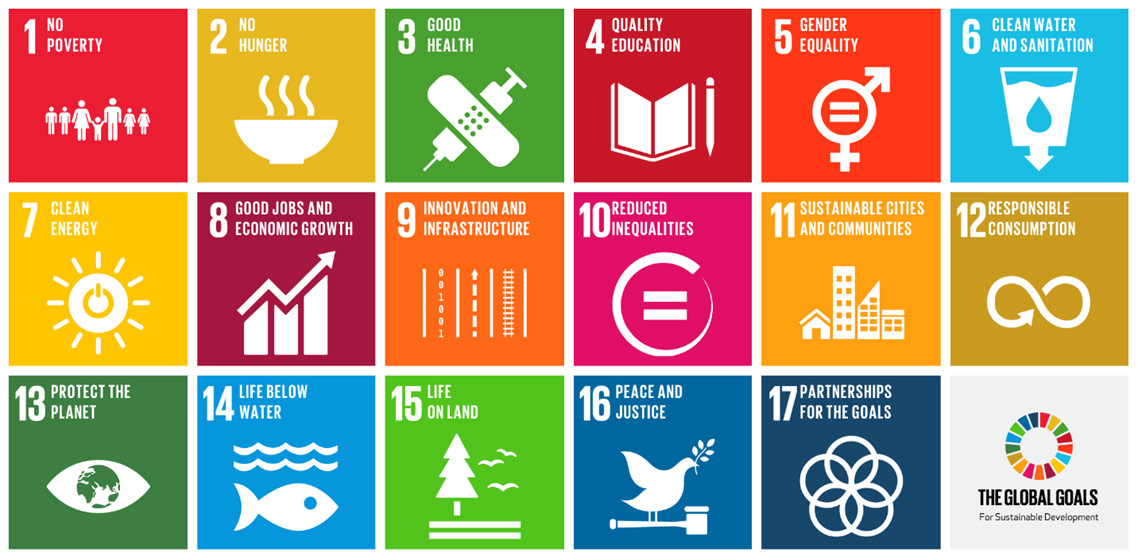
Bamboo can play a key role in many of the SDGs, but although the goals are inter-related, the relevance of bamboo is not the same for all. Moreover, as bamboo does not grow everywhere on our planet, the relevance of bamboo for each SDG varies from country to country.
The first goal (End Poverty) is maybe the most critical SDG and bamboo can certainly play a role. In China, bamboo has been instrumental in raising millions of local farmers and their families out of poverty, and in northeast India most local communities depend on bamboo for their livelihoods. Bamboo can provide a solid source of income, starting from harvest and collection to processing, manufacturing and trade.
In addition, bamboo shoots provide food for human consumption, while bamboo leaves provide fodder for livestock. Mushrooms thrive in bamboo litter, and free-range fowl in bamboo woodlots eat bamboo leaves while providing natural fertiliser for young bamboo. All of this helps to reduce poverty and improve livelihoods.
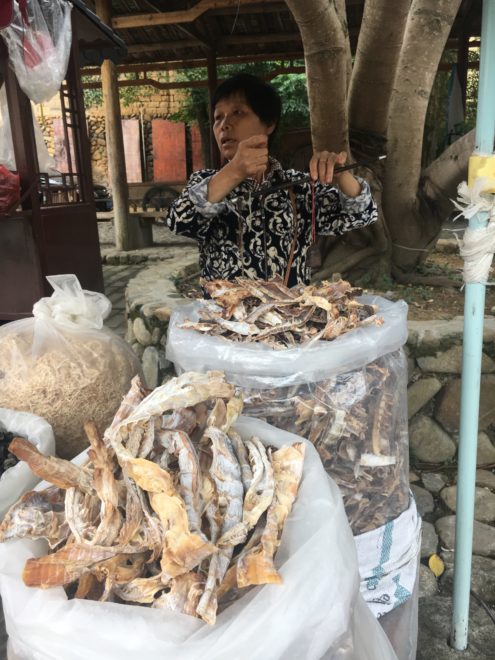
Dried bamboo shoots
SDG 7 (Affordable and Clean Energy) aims to increase the share of renewable energy in the global energy mix, and bamboo is an excellent source of renewable energy.
The United Nations Forum on Forests estimates that more than 2 billion people still rely on wood fuel to meet their primary energy needs such as cooking and heating, and much of this is charcoal. Most of the wood is generally harvested unsustainably, often illegally and this is a principal driver of deforestation in some countries. Bamboo could be a sustainable alternative for wood charcoal, especially in Africa and Asia, and lucrative African bamboo charcoal enterprises for household fuel already exist in Ethiopia, Ghana, Uganda and Zambia.
At a larger industrial scale, bamboo can be chipped or pellets can be made from waste, and this can be used to fire generators through gasification. Research is under way in India, Indonesia and Japan to determine how best to establish large-scale power generation based on bamboo plantations.
As an innovative recent solution for energy provision, bamboo fibre can also be used to manufacture the blades of turbines for hydropower and wind energy. This is an emerging field of research and development, but the first modern windmills with bamboo blades are in operation in China.
Goal 8 (Decent Work and Economic Growth) includes targets that aim to achieve higher levels of economic productivity through diversification and innovation and to encourage the development of micro-, small- and medium-sized enterprises.
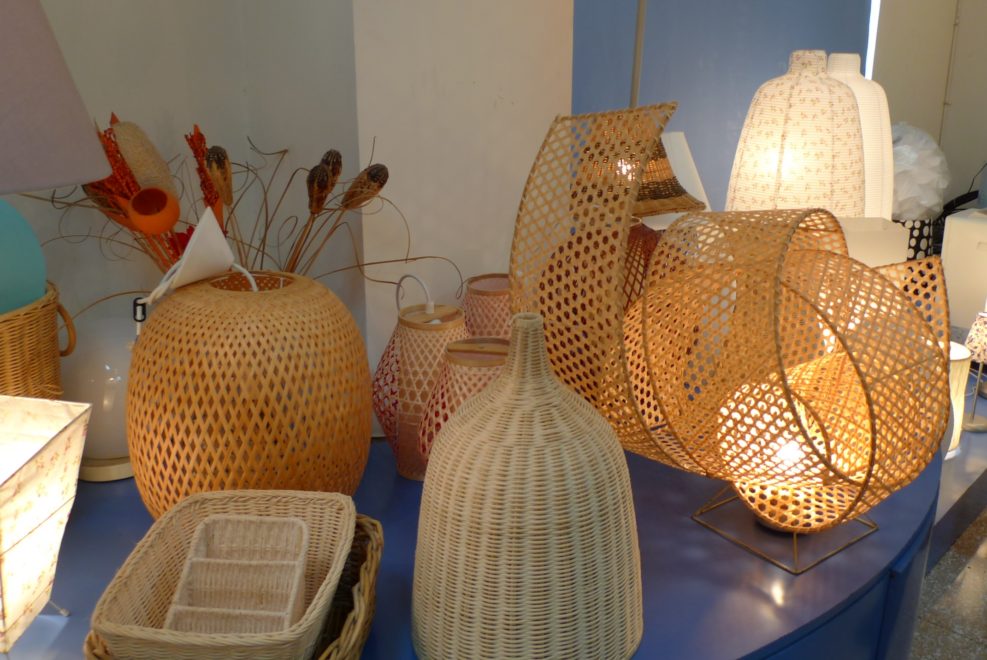
Bamboo lamp shades in Qingshen County, Sichuan Province, China
China and India together employ some 20 million people in bamboo development and manufacturing, and many more are involved around the world, with some reports suggesting that globally 1 billion people depend on bamboo. Bamboo-related jobs range from managing plantations and harvesting of poles and bamboo shoots, via pre-processing like sorting, cleaning, cutting, treatment and splitting to production of raw material, manufacturing of simple products and to the assembly and trade of high-end design and innovation tools. This currently involves mainly small and medium sized enterprises, both in production countries where the bamboo plants grow, and in consumer countries where the bamboo goods are used.
SDG 11 (Sustainable Cities and Communities) includes a target to ensure access for all to adequate, safe and affordable housing, and aims to significantly reduce the number of people affected by disasters.
For affordable housing and dwellings that can be rapidly erected to respond to earthquakes or floods and other disasters, bamboo is emerging as the construction material of choice. A number of documented cases in Latin America testify how bamboo structures better withstand the impact of earthquakes than concrete housing, and this understanding is now being applied in other countries, like Nepal. Once bamboo culms are harvested they need treatment, as bamboo contains natural sugars and starch, and treatment can be done with natural compounds like of boric acid or borax salt. Treated bamboo poles have a service life of 50 years or more, and traditionally, the poles have been used for construction in Asia and Latin America during centuries.
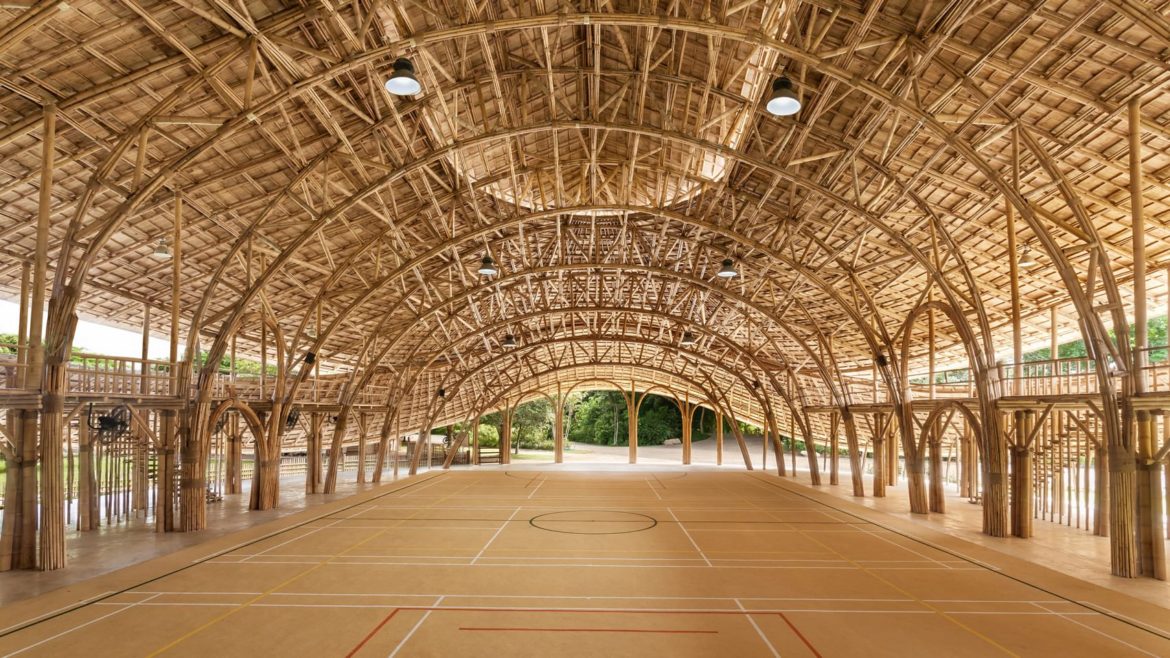
Panyaden International-School in Chiang Mai, Thailand. Design and photo by Chiangmai Life Architects.
On the other hand, in the world of modern urban construction, more top architects and designers are specifying bamboo for their creations, due to its durability, look and sustainability aspects. Modern construction is using so-called engineered bamboo, which is effectively a process of splitting natural culms into strips which are glued back together under pressure as beams or panels.
Goal 12 (Responsible Consumption and Production) aims to achieve the sustainable management and efficient use of natural resources.
One of the specific targets of SDG12 is to reduce waste, and bamboo is an excellent tool to reach this target. In fact, every part of the bamboo plant can be used for manufacturing. Moreover, many used bamboo products can be recycled into other uses.
SDG 12 also promotes green public procurement practices, and this is another area where bamboo can contribute. For example, bamboo fibres in reinforced composite material are used to manufacture large drainage pipes in China. The bamboo fibre products can replace most concrete, polyethylene and other traditional pipes in the market, and can be widely applied to municipal water supply and drainage networks anywhere in the world.
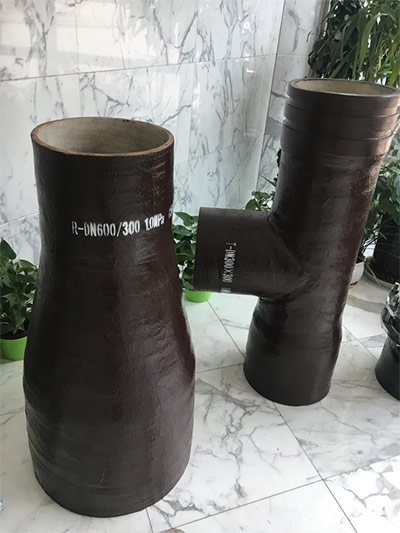
Bamboo Fibre Pipes
Goal 13 (Climate Action) aims to strengthen resilience to climate-related hazards, while promoting mechanisms to mitigate climate change. Bamboo can help with all of this.
Like other plants and trees, bamboo absorbs CO2, and research has established that a well-managed bamboo grove absorbs more CO2 than an equivalent woodlot of Chinese fir. Carbon in bamboo plantations is measured as a combination of a) Total Ecosystem Carbon in the natural environment, b) carbon locked up in harvested bamboo products, and c) potential carbon contribution as a displacement of abiotic products with bamboo products. A well-managed bamboo woodlot therefore provides a secure carbon sink, and recent calculations estimate the carbon storage to be as much as 530 tC/ha.
Bamboo is also an import tool for adaptation to climate change effects. Bamboo bends, and does not break, and planted bamboo can withstand the effects of extreme climate. A farmer who has included bamboo in her agro-forestry system has added options for economic survival compared to a farmer who depends on producing fruit and vegetables only.
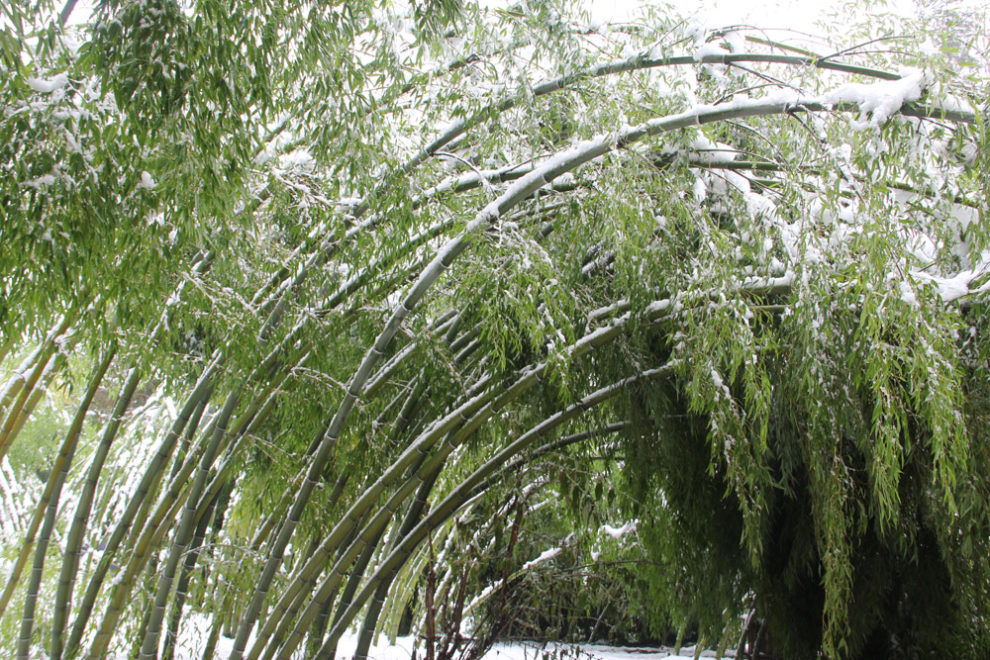
Bamboo bends but does not break
SDG 15 (Life on Land) is particularly relevant for bamboo. Habitat provision and biodiversity conservation is one of the key values of bamboo forests, with critical species like Mountain Gorillas in East and Central Africa, lemurs in Madagascar, Red Panda in the Himal Region and the Giant Panda in southern China. But there are also frogs and many other species that live in bamboo forests.
The extensive root and rhizome system make bamboo a unique and effective tool to control erosion, maintain slope stability and avoid landslides. Several countries in the global South use bamboos along river banks for protection, and other countries are using bamboo to restore degraded land. Many successful examples are listed in a 2018 FAO-INBAR publication including case studies from China, Colombia, Ghana, India and Thailand to name a few.
Sustainable land management is also an issue that is critical for southern Europe, and bamboo could help here as well. We know that bamboo can grow in Europe as there are healthy bamboo nurseries and small woodlots in France, Italy, Portugal and Spain. There is also a real interest in reviving and diversifying local agricultural production in the South of Europe, and the European Union is calling for a New Green Deal.
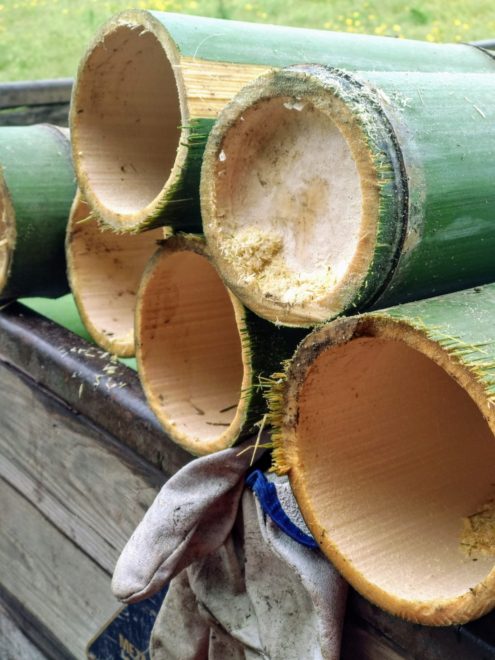
Conclusion
Bamboos can play a key role in several of the Sustainable Development Goals. That does not mean bamboo has no role in Health and Wellbeing, Gender Equality or some other SDGs, but the list above covers those areas where the impact may be most effective. There are also some fundamental challenges to overcome, and celebrating World Bamboo Day every year on 18 September is one way to start to address them.
The specific relevance of bamboo plants and products varies from country to country, but they should be considered in the National Socio-economic Development Plans and in Nationally Determined Contributions to the Paris Agreement, especially in countries where bamboo is part of the natural flora. And, as there are also real opportunities for the development of bamboo in Europe, the importance for bamboo should not be overlooked in this Region either.

Excellent. Thank you Hans. Keep safe.